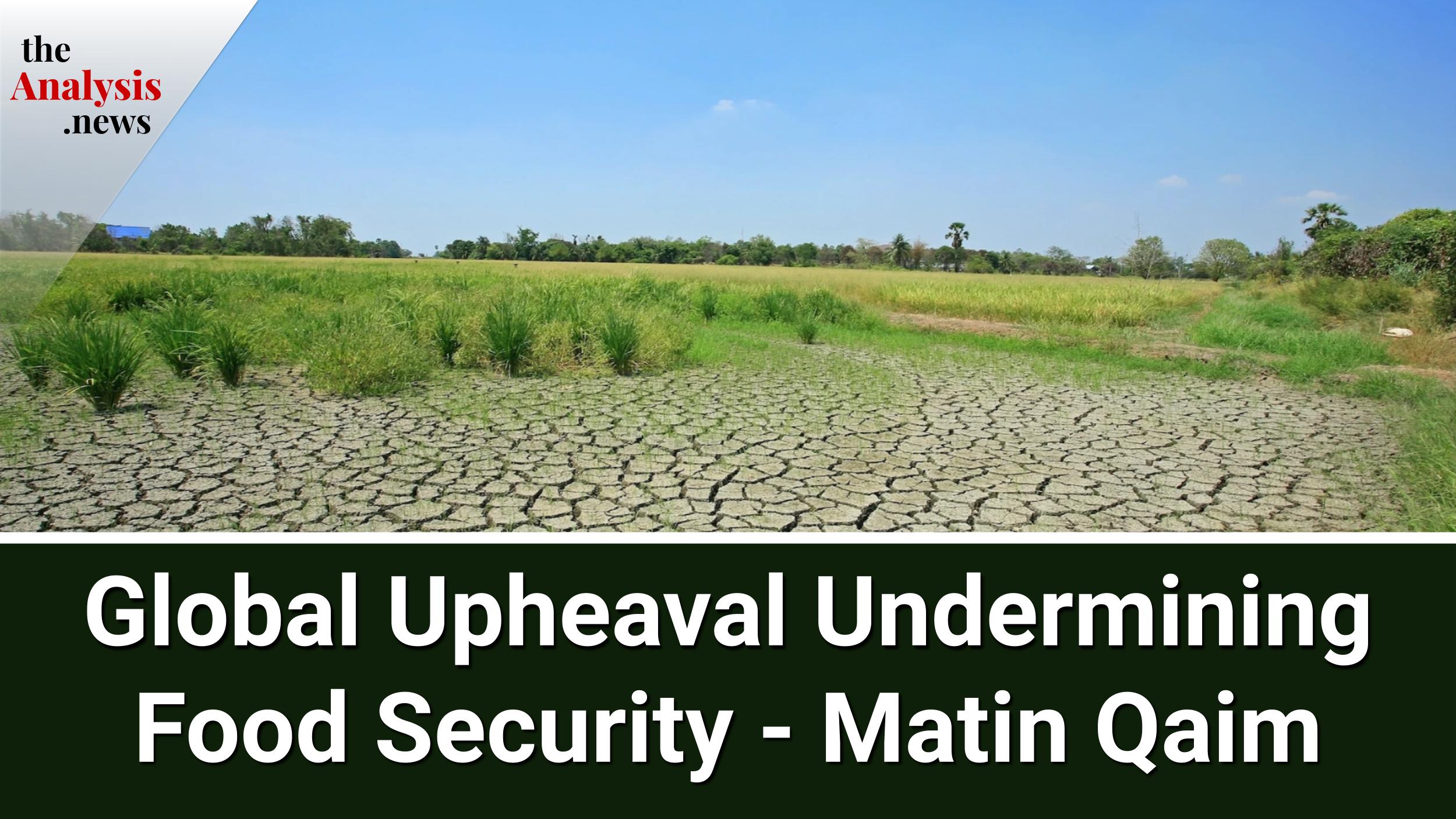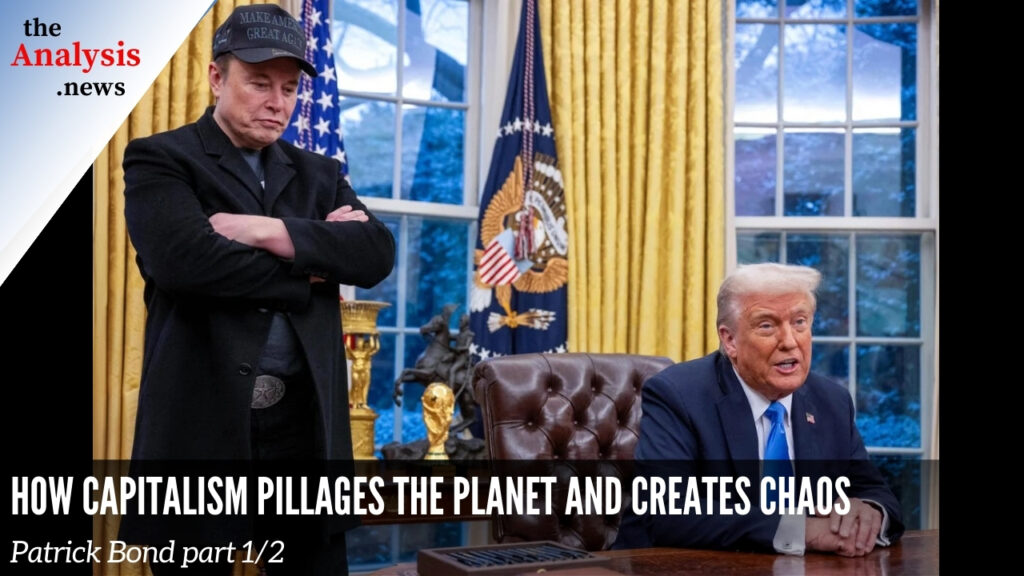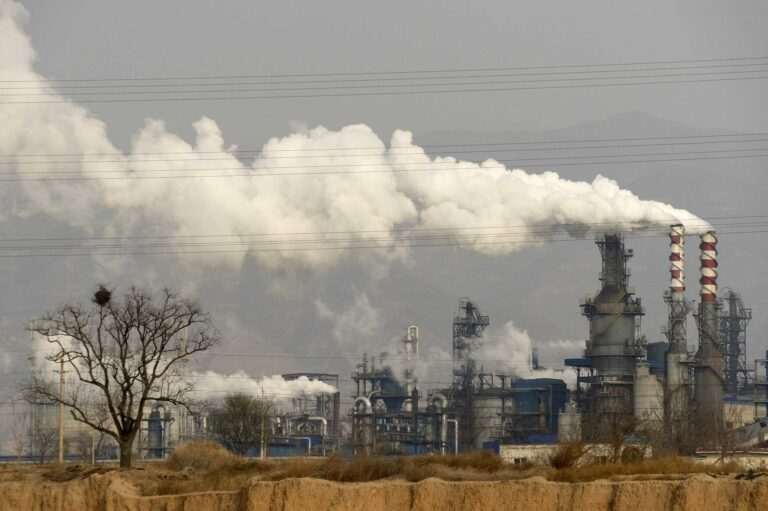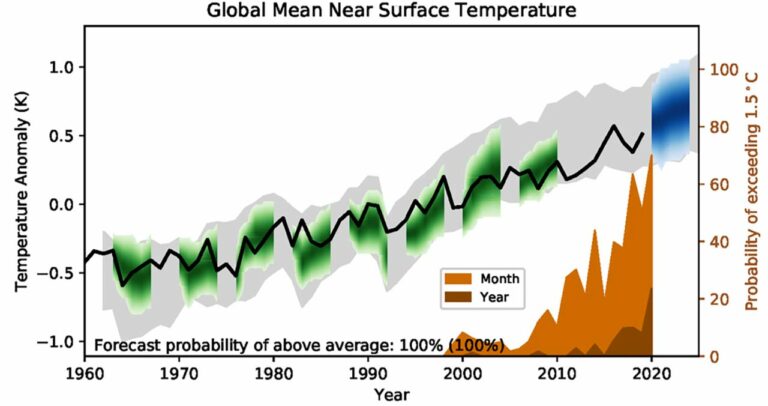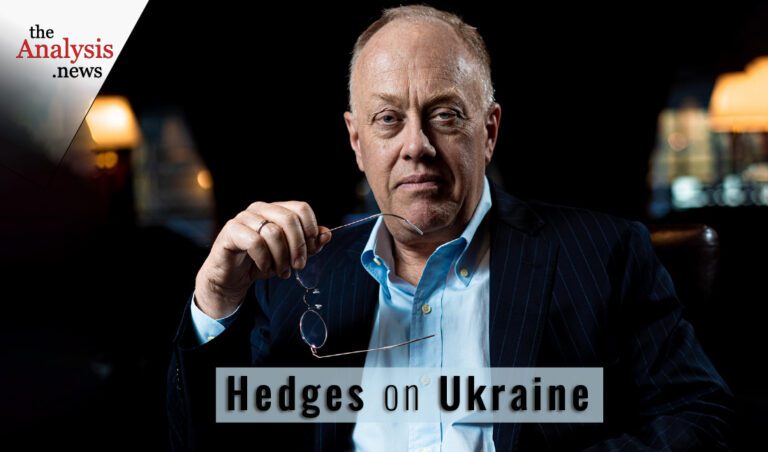Matin Qaim, Director of the Center for Development Research at the University of Bonn, examines the various aspects comprising food security, namely local and global supply chains, the generation of income for local farmers, investments in the production of nutritious foods, as well as accounting for climate externalities. Attaining food security has become even more difficult given the disruptions around the pandemic, rising inflation, and the failed Black Sea grain deal. He asserts that small-scale farming and agroecological approaches are not necessarily low-tech and that certain technologies, if applied correctly, can assist smallholder farmers.
Talia Baroncelli
Hi, I’m Talia Baroncelli, and you’re watching theAnalysis.news. I’ll shortly be joined by economist Dr. Matin Qaim to speak about food security globally. If you’re watching the show for the first time, please consider going to our website, theAnalysis.news, and getting on our mailing list; that way, you’ll be notified every time a new episode drops. You can also donate to the show by hitting the donate button at the top right corner of the screen. See you in a bit with Dr. Matin Qaim.
Joining me now to speak about issues of food security is Professor Matin Qaim. He’s the director of the Center for Development Research in Bonn here in Germany. So thank you very much for joining me today, professor.
Matin Qaim
Thanks for having me.
Talia Baroncelli
Well, one of the entry points into our discussion today is obviously the grain deal between Russia and Ukraine, which, unfortunately, has fallen through. Over the past year, this grain deal has really helped the Global South with food security to ensure that they are able to put enough food on the table. Perhaps we can first discuss what the implications are of this grain deal falling apart.
Matin Qaim
Yes, sure. Last year when the Russian aggression and the war broke out in February, we had to understand that both Russia and Ukraine are not only very large food producers but also very large food exporters. Together these two countries export around a third of the total wheat that’s traded internationally. For maize, it’s also large for other grains, for sunflower oil, large quantities and large shares. Most of these exports go out through the Black Sea, normally, and Black Sea harbors.
With the outbreak of the war, for a couple of weeks, there were no ships going out because it was a war zone. Then the Russian ships started to go out, but the Ukrainian ships did not because they were blockaded by Russian ships, and they couldn’t leave the ports without being shot. That situation persisted for a couple of months, and it led to skyrocketing prices on international markets. That means all those countries that are dependent on food imports had to pay much, much more. Prices were doubled in a relatively short period of time. They didn’t only have to pay much, much more, but some of these countries were unable to get the quantities they needed because there was this shortage in international markets.
In the summer of 2022, this grain deal between Russia and Ukraine, with the backing of Turkey and the United Nations, was implemented and established. That meant that gradually the Ukraine exports could resume, leading to the coming down of market prices. Internationally it went down to normal levels. They were still high but much lower than they used to be during peak times. That was good because many of the poor countries with food insecurity are importers of food, and that means they had much better access, and some of the worst crises that we were all concerned about could be prevented.
This situation came to a halt, with Russia stepping out of this deal recently. Now prices for grains are going up internationally again. They haven’t shot up to the doubling of prices, but they have gone up for the last ten days. There are some concerns. Again, food insecurity is increasing in the world. We are particularly looking at a bunch of countries in Africa, the Middle East, and Asia. There’s a scarcity of quantity. There’s uncertainty.
The situation is not as bleak as it used to be in 2022, simply because some of the quantities now go out via land from Ukraine. They go out by train, they go out by trucks, and so parts of the exports happen. But still, it’s a situation that’s increasing the international risks of food insecurity.
Talia Baroncelli
Well, Ukraine has been known as the “breadbasket” of the world, and of course, Ukraine has provided so much grain to the Global South, but it’s not the only source of grain in different cereals. What have countries been doing to meet their agricultural and food needs? Have they been diversifying, or have there been more, perhaps projects on the ground or subsidies to be able to become more self-subsistent or self-sufficient?
Matin Qaim
Yeah, a bunch of different things. First of all, there are other countries exporting, but Russia is the largest wheat exporter. Russia continues to export. Russia had a good harvest in 2022 and also a very good harvest as it seems to be this year. Russia is trying to make up for some of the quantities that Ukraine is not exporting. Russia is basically stepping out of the grain deal in order to hurt Ukraine. Ukraine is not able to export. Russia is benefiting from rising prices by selling its own wheat and promising some African countries we will provide you with the wheat.
Obviously, that’s the narrative that President Putin is providing, and that’s not necessarily in the interest of African countries or the rest of the world. Obviously, all prices were high. Every country that needed to import was trying in the short run to get imports from somewhere else. Hunger numbers did increase, but not as much as people were concerned about. Producing more is certainly an option that can only go so far because you only have the land resources in your country that you have and you cannot extend the land resources. Using more fertilizer is generally an option for some countries, but it was difficult because fertilizer prices were skyrocketing as well. This means there aren’t short-term measures that countries could implement in order to really increase their own production.
Of course, in the longer run, investing in new types of technologies is an option, but that’s not happening overnight. The question of where the foods coming from that some African countries need in the future remains a relevant question. Increasing African-owned agricultural production is an important goal, but obviously, that needs investment, which takes some time.
Talia Baroncelli
Well, before we get into some of those other technologies, I was wondering, before the war in Ukraine, these other factors, economic factors, were also affecting food security. Such as the pandemic, which had all sorts of supply chain issues and, of course, inflation. Have you seen countries become a bit more resilient, particularly in the Global South, to be better equipped to deal with these issues? Has it become worse in the past few years?
Matin Qaim
First of all, it has become worse in the past few years. Those factors that you mentioned contributed to a situation of food insecurity that was there anyway. We still have a world where close to 800 million people are going hungry to bed every night. The pandemic led to a situation where hunger numbers increased, and the supply chain disruptions you mentioned were an important part of that.
The other part that’s often not sufficiently clearly seen is the income losses that the lockdown measures that were implemented in most countries really meant. You’re talking about poor people who are deriving their income from informal employment, and all this informal employment for a number of months just stopped. This means the income stream stopped. So it was not only that prices of foods increased, but at the same time, incomes decreased. This is a clear reason for increasing hunger, especially among poor people who need to spend a large share of their income on food anyway. The inflation continued not only because of the COVID pandemic but also because of rising energy prices and other international issues, and the Russian war.
We are still seeing a situation where food prices are high by historical standards, and this is making the goal of food security more difficult. So, yes, we are living in challenging times, and food security cannot be taken for granted, unfortunately.
Talia Baroncelli
So if countries are so integrated into the world economy, how can they ensure that they have food security? How much control do they even have over world prices? Is there anything that they can do in terms of local strategies to lower those prices or to make access to food more affordable?
Matin Qaim
Every country, of course, from a resilience perspective, needs to see what’s produced at home and where you lie on international markets. We are looking especially with a view to Africa, to a situation where the population numbers are increasing, and the land resources are scarce. That’s something that we’re also seeing in many parts of Asia, not only in Africa.
Many developing countries, even if they increase their agricultural production, which should have high priority, will not become self-sufficient overall in food. They will depend on food imports. This is one of the reasons why the borders need to stay open. There is nothing like food self-sufficiency for every country. If all countries closed down their borders, we would have numbers of hungry people that are probably three or four times as high as they are anyway.
That’s also the reason why Russia and Ukraine, with not-so-large populations but a lot of land and a lot of water available, are major exporters. We have an unequal distribution or an unequal ratio of population versus land and water resources. This will even become worse with climate change because climate change, all the predictions and all the models are telling us the countries worst affected are those in the Global South, the countries in Africa, and the countries in Asia where heat waves and agricultural production will become so difficult and also much more erratic. There is a drought in one season. There is suddenly a flood in another season, and of course, agriculture production suffers from that.
These effects will be much worse in Africa and Asia than in Europe, for instance. This leads to the additional insight that without trade, this is not going to work. Countries should increase their agriculture production by wise investments to the extent possible. But that’s not the case; instead of imports, imports will remain important for many countries and diversification— not being dependent on one or two countries. This is what may help countries to not be too affected by international disruptions because if one country drops out, which can always happen, then you have a sufficient number of other sources where you get your food from.
Talia Baroncelli
Well, you did mention trade, which is, of course, a very important factor. But how do you balance the right amount of trade with trying to avoid the destruction of local economies and with even instituting certain protectionist measures? The E.U., for example, heavily subsidizes its agricultural sector. If certain African countries were to do the same, would that help them out, or would that have the opposite effect?
Matin Qaim
The question is, what do we mean by subsidies? What we need in Africa is a major investment in agriculture, which means agricultural technology. This means agricultural training and education for farmers. This means improved road and irrigation infrastructure. Major investments are needed. This is, of course, a subsidy that money has to come from public funds, be it African governments, but certainly also to some extent from the international donor community.
African and Asian countries are well advised to prioritize investments in agriculture because it’s so important for food security. It’s not only for producing more food. It’s also because many of the poor and hungry people are farmers. It’s also providing an improvement in their income-earning potential by increasing their productivity. This is really important. When we talk about resilience, then so far, we have talked mostly about resilience, meaning insulation from international shocks. But resilience also means being resilient to climate shocks. When you have closed borders, and you’re doing everything at home and a climate shock strikes, you’re much less resilient. You need to balance international sourcing with local production.
I think the answer to what the right balance is depends on the conditions in every country. How much land do you have? What potential do you have to produce certain types of crops versus others? What other economic potentials do you have in order to provide income and employment for your local population? There is no one size fits all solution. I think the general statement that we need stronger investments in African agriculture is certainly one that holds across the board.
Talia Baroncelli
Would this investment be primarily for larger agricultural companies like big agrochemical companies, or would there be a way to encourage small-scale forms of farming, such as agroecological forms of farming? What would those small forms of farming actually look like on a bigger scale?
Matin Qaim
A focus on the small farm sector is very important simply because hundreds of millions of poor people depend on small-scale farming for their livelihoods. We can’t imagine a situation of only large-scale farms where all of these people would lose their jobs and their livelihoods. A focus on small farms is important, but small farms don’t necessarily mean it’s low-tech. Small farms also need access to good technology, be it improved seeds that are not only high yielding but also robust to climatic and weather shocks that are resistant to pests and diseases. Small-scale farmers may also benefit from certain forms of digital technologies providing better access to information, better access to weather forecasts and market intelligence.
What we shouldn’t do is equate small-scale farming with subsistence low-tech agriculture. We need to make small-scale farmers fit for the market with the best appropriate and locally adapted technologies available. That is technology that partly has to come from the public sector, but obviously, also technology that can come to some extent from the private sector. There’s nothing against competitive markets and companies providing technologies to small-scale farmers as long as these technologies are targeting the needs of small-scale farmers and are accessible in terms of what they cost and what the benefits are that they can bring to smallholders.
Talia Baroncelli
Arguably, the market hasn’t really been the best arbiter or efficient way to ensure that farmers are able to get all of their goods on the local or the international market. It seems like there’s been a lot of waste when it comes to food. A lot of food is wasted. Not everything that is produced is actually consumed. There are also inequalities between what certain people consume in terms of nutrition and the content of the food they’re consuming versus people in perhaps wealthier countries.
What would the interventions be in the market, the economic interventions necessary to ensure that people are consuming enough food that’s actually nutritionally dense, so to speak and that there aren’t as many inequalities?
Matin Qaim
One of the important factors is that a few preconditions need to be met for markets to be able to work efficiently and fairly. I’ll give you an example of road infrastructure. If small-scale farmers and communities have no access to roads, they cannot get the inputs and technologies they need on time and cannot market their produce. If they market it with very bad road conditions, a lot of this will be lost and spoiled. Here we need investments in improved infrastructure, which can only come from the public sector. There is no company that will build the road to a small-scale village, at least most of the time, so this is really something where public investments are needed. Once that public investment is made, markets start to work better, and private sector involvement will increase.
You did mention access to nutritious foods. Infrastructure is particularly important for perishable fruits and vegetables and these types of foods. When you have a truck of grain or even a donkey cart of grain, that’s not going to spoil as fast. Even if it takes longer and there is a bumpy road, you will get your wheat or your rice grain to the market, but not your tomatoes and not your pumpkins and what have you. On a bumpy road, they would spoil and be damaged. If it’s not getting there fast enough and it’s not under some cooling conditions, it’s not going to work.
This is one of the reasons why access to really nutritious foods is so difficult, especially for poor people in rural areas. They may harvest some of the nutritious foods during certain seasons of the year, but for the rest of the year, they are running without access to sufficient nutritious foods because it’s not reaching their places, coming in from other places.
Markets aren’t necessarily bad, but markets need to be put into a position where they can work, and that’s what’s key.
Talia Baroncelli
When it comes to nutrition, I’m sure this is a very complex issue, but would you say it’s more of a supply-side or a demand-side issue? Is it more about investing in this particular green leafy vegetables or other produce that’s really healthy and nutritious and ensuring that those prices are maybe kept low so that people can afford them? Or is it also about educating people to buy the right products and to incentivize them to consume healthy food?
Matin Qaim
It’s a mixture of both, obviously. So far, when you’re educating people and making them aware of how important it is to eat enough quantities of nutritious foods, but it is either not available or they are very expensive during large parts of the year, then the whole awareness building doesn’t really help.
On the other hand, if you’re producing much, much more and increase availability and prices are reduced, but there is no awareness, I mean, it’s also culturally that people obviously are adjusted to what is available at affordable prices. So yes, that type of awareness building and changing consumption behavior and preferences is important as well. I think that the whole question of food security, we need to always keep both the supply side and the demand side in the picture.
When we look at how we can, on our small planet, actually ensure that there is sufficient food produced for 10 billion people and potentially more, well, it’s going to work partly with the right technologies. It’s not going to work when we’re all consuming and having lifestyles as we here in Western Europe tend to have with lots of meat and animal-sourced food consumption. It’s a mixture of consumption changes that will be required not only for poor people suffering from food insecurity but also for rich people and countries with too much waste, using too many resources, and have a climate and environmental footprint. That’s just completely unfair from a global perspective.
Talia Baroncelli
We’re getting into the issue of climate change now that you’ve just brought that up. How do these policies of food security ensure that there’s still a certain amount of biodiversity maintained or that there aren’t high levels of land degradation, and that externalities, environmental externalities or planetary boundaries, the limits of the planet and the ecosystems we’re living in? How do food security experts deal with those issues and try to find ways around them?
Matin Qaim
The goal is to provide sustainable food security and sustainable means that is not only about enough healthy food for human health, but we also need to preserve environmental health. It’s for the planet as a whole. When we are looking at how much food and agriculture contribute to some of the big environmental issues, climate change, and biodiversity loss, we see, wow, it’s tremendous. The food and agriculture sector is responsible for about one-third of all climate gas emissions, and it’s very clear that we can’t continue like this. If we want to get to a climate-neutral economy, then it’s also the agricultural sector that needs to find ways of emitting less climate gases.
It is the same for biodiversity. When you’re looking at the biggest threats to biodiversity internationally, it’s the expansion of agricultural land into the forest and natural habitats. In a way, we need to find technologies that need less land because land conversion is not only the biggest threat to biodiversity but is also one of the major sources of greenhouse gas emissions. If you’re considering a hectare of forest that you’re deforesting in order to plant wheat, all the carbon that’s in the soil and in the biomass is lost. It is going into the atmosphere, and it is contributing to climate change. It is one of the big, big sources of greenhouse gas emissions. Agriculture on less land can only work with better technologies. Better technologies that provide more per hectare of land. This is one of the avenues.
The other avenue is we need to change consumption styles. A meat-heavy diet needs so much more land and leads to so much more greenhouse gas emissions than a plant-based diet. This means plant-based diets, which doesn’t necessarily mean we all have to become vegans, but we seriously need to reduce high quantities of meat and animal-sourced foods. That’s true for people who eat a lot, and that’s for most people in the rich world.
If you look at Africa, for instance, where poor people eat very little animal-sourced foods, you would say, well, animal-sourced foods also have a role to play in healthy nutrition to some extent. We need, obviously, locally adjusted solutions. The consumption side is an important factor in this.
Talia Baroncelli
One last question. What would the role of fertilizers and pesticides be? You’ve mentioned now that we need to stop burning fossil fuels and we need to decarbonize. What do big agrochemical companies, what role do they play? Is it just the pesticides and fertilizers themselves that have environmental impacts? Or is it the companies themselves and their scope of one to three emissions that have other downstream effects and other effects on the agricultural sector that are also potentially contributing to these environmental catastrophes?
Matin Qaim
Fertilizers do contribute to greenhouse gas emissions through two channels. The first is producing nitrogen. Fertilizer is very energy intensive, and this energy today comes primarily from burning fossil fuels. Fertilizer production is responsible for about 1% of global greenhouse gas emissions.
The other factor of how fertilizer contributes to greenhouse gas emissions is because the nitrogen compounds lead to certain nitrous oxide emissions, which are potent greenhouse gases when you’re applying them to the field, especially if you’re applying them under conditions that are not technically sound. Yes, fertilizers contribute to climate change.
However, the share of how much fertilizers contribute to climate change is probably less than what you expect. It’s less than 10% of all the emissions from agriculture. I mentioned that food and agriculture are responsible for about one-third of the greenhouse gas emissions. Only one-tenth of this is due to fertilizer.
The much bigger source of greenhouse gas emissions is, on the one hand, livestock keeping and is, on the other hand, land use change. If we’re using fertilizers in order to prevent more forests from being cut down, then we are actually doing something good for the climate.
This is not necessarily the case in Western Europe, where we use a lot of fertilizer anyway. Here reductions in fertilizers would be useful. If you look at many places in Africa where smaller farmers hardly use any fertilizer because they don’t have access to fertilizer, they often, in order to produce more, go into the forest. They cut down the forest in order to produce more. If they were given better access to fertilizers, that deforestation could be less.
Starting from very low amounts of fertilizers, increasing fertilizer use is something that’s good for the climate and the environment because it has so many positive effects on saving land. So it’s not necessarily a zero fertilizer world that’s the perfect world. It’s a world that has much less fertilizer used than what we typically use here in Europe. China is also using heavy amounts of fertilizer. We need to see the trade-offs. Finding ways and technologies that help to have a lot of production per unit of land is something good. I’m not saying fertilizer is the only way of doing that. We need certain amounts of fertilizers, but obviously, good breeding and good technology can help plants grow well with less fertilizer because their root systems use the fertilizers better or we are applying the fertilizers in a more targeted way. All of these are useful technologies. A zero fertilizer world is one that’s problematic because when we are harvesting, we are extracting nutrients from the field, and to some extent, we need to get the nutrients back onto the field; otherwise, there is no sustainable harvest in the future.
Talia Baroncelli
And that would be the same for pesticides than that you would have to…
Matin Qaim
Pesticides really have to be seen in a slightly different way because pesticides are not adding nutrients. Pesticides are one way of dealing with the problem of pest pressure. Here I think that other technical ways of dealing with pests have a large potential. More resistant varieties, for instance, more diversity in the fields, can help to reduce pest pressure. Agroforestry systems where you combine trees with annual crops can really help to reduce pest pressure. I’m not necessarily saying that everything can be done completely with zero pesticides, but there are very interesting technical options and agronomic options to reduce the use of chemical pesticides, and that’s an important avenue for more sustainable production systems.
Talia Baroncelli
Well, there’s no one size fits all. I think that’s the takeaway from what you’ve said. You need very particular local ways of dealing with these issues and ways which are also connected to the global economy. Still, there’s no single solution or one approach to enhancing food security. So Dr. Matin Qaim from the Center for Development Research in Bonn, thank you very much for joining me today and sharing your insights.
Matin Qaim
Well, thanks for having me.
Talia Baroncelli
Thank you for watching this interview on theAnalysis.news. We really can’t make this content without you, so please consider going to our website, theAnalysis.news, and hitting the donate button at the top right corner of the screen. Get on our mailing list so you don’t miss any future episodes, and see you next time.
Podcast: Play in new window | Download | Embed
Subscribe Apple Podcasts | Spotify | Android | iHeartRadio | Blubrry | TuneIn | Deezer | RSS
Never miss another story
Subscribe to theAnalysis.news – Newsletter
Matin Qaim is the Schlegel Professor of Agricultural Economics and Director at the Center for Development Research of the University of Bonn, Germany. His research focuses on issues of food security and sustainable development.
